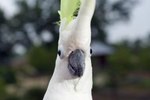
Storks have long been considered symbols of good luck. Images of a great white bird carrying a newborn baby in its bill still grace many a baby shower. A variety of types of storks live all over the world. Storks have either straight or curving bills, and some species resemble vultures -- down to the bald heads and a taste for carrion.
Stork Characteristics
There are 19 species of stork inhabiting many parts of the globe where the climate is warm. Storks are part of the family Ciconiidae, closely related to flamingos, ibises and herons. Storks have long legs and webbed toes ideal for wading in shallow water to catch fish. Storks aren’t songbirds; they're only capable of hissing, grunting and clattering their beaks. Storks build huge nests in trees where both parents care for the young.
Typical Storks
Storks are categorized into two main groups depending on the shape of the bill. Typical storks are the first group -- they have straight bills and make up the genus mycteriinae. The European white stork, which is found in Europe, Northern Africa and Asia, is an example of a typical stork. White storks have long, straight and narrow beaks and are perhaps the most recognized species of stork, with their white body and fringes of dark back feathers on their backs and wings. The black stork lives in Europe, Asia and Africa and has a black body, a white belly and a straight, red bill.
Wood Stork
Wood storks are the second main type of stork. They have a decurved bill, meaning it curves downward. Storks of this type make up the genus mycteriinae. The wood stork is the only stork native to North America. It has white feathers with black-tipped wings and a bald head. The yellow-billed stork of Africa is another wood stork, with white feathers, red face and bright yellow bill.
Scavenger Storks
Storks belonging to the genus leptoptilos resemble vultures, both in appearance and appetite. They have heads and necks devoid of feathers, and are none to pleasant to look at. Their favorite food is carrion, happily eating the leftovers of large predators. There are three members of this group, the lesser and greater adjutant and the marabou stork. The adjutant storks live in India and Asia. The marabou stork of Africa is the world’s largest stork, growing up to 5 feet tall.
Other Storks
The two varieties of openbill storks, African and Asian, belong to genus anastomus. When these storks shut their bill a gap remains, useful for eating snails. The jabiru stork belongs to its own genus of the same name. It's a very rare, endangered species of stork native to Central and South America. The black-necked stork and saddle-billed stork belong to genus ephippiorhynchus. These storks have long, upturned bills.
References
Photo Credits
-
Stockbyte/Stockbyte/Getty Images




